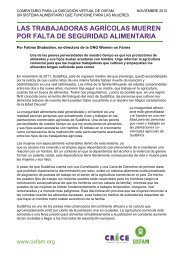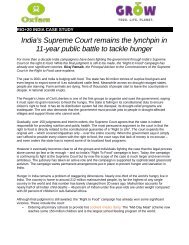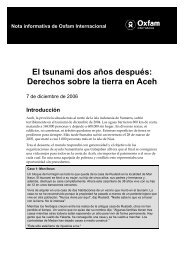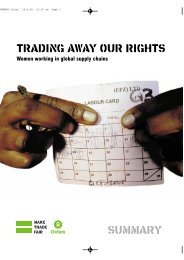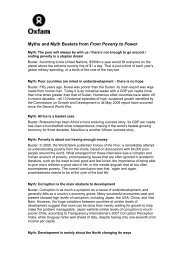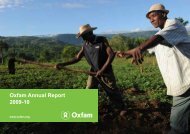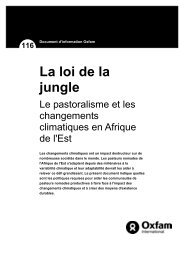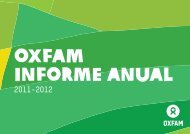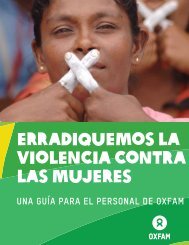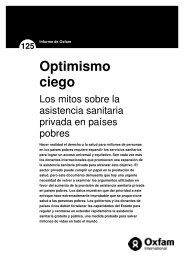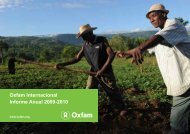Architect. summary report - Oxfam International
Architect. summary report - Oxfam International
Architect. summary report - Oxfam International
You also want an ePaper? Increase the reach of your titles
YUMPU automatically turns print PDFs into web optimized ePapers that Google loves.
The perceived need for the Tsunami Fund as a separate legal<br />
entity reflects the view that <strong>Oxfam</strong> had not yet established a<br />
system for transferring funds speedily, efficiently, and fairly<br />
between affiliates. When the tsunami made such a system<br />
necessary, the Fund (and Audit Committee) were created to fill<br />
the gap. However, the TFMT evolved out of the Humanitarian<br />
Consortium and the HC Management Group, and derived<br />
experience and credibility from these bodies. Humanitarian<br />
Country Teams, which provided the third pillar of the tsunami<br />
architecture, were already in existence, though new and<br />
inexperienced. The architecture was therefore partly new,<br />
partly an adaptation, and partly a continuation of an<br />
existing structure.<br />
Appreciation of the quality<br />
of <strong>Oxfam</strong>’s response<br />
4. The majority of respondents to the main questionnaire<br />
thought that the quality of <strong>Oxfam</strong>’s tsunami response was<br />
up to or exceeded the standard they expected from <strong>Oxfam</strong>,<br />
throughout the response. The majority of respondents thought<br />
that the architecture had a positive impact on the quality of<br />
<strong>Oxfam</strong>’s response.<br />
Appreciation of the architecture<br />
5. The impact and value of the architecture were not seen<br />
as very significant during the initial phase of the response.<br />
Appreciation grew during the middle and later phases.<br />
However, during the later phase ‘fatigue’ was <strong>report</strong>ed, as<br />
structures and procedures that had necessarily been put<br />
together at speed were still in place two or three years later<br />
and under considerable strain.<br />
6. On the whole, ‘upstream’ respondents (such as TF Board and<br />
TFMT members and staff) are more positive about the value of<br />
the architecture than those closer to the action (such as fieldbased<br />
HCT members). However, there are exceptions at both<br />
ends of the spectrum.<br />
7. Views differ about the need for and value of the Tsunami<br />
Fund as a separate UK-registered charity. Some respondents<br />
close to the TF question whether it was actually necessary<br />
and suggest that the Executive Directors and existing interaffiliate<br />
contractual arrangements could have handled the<br />
responsibility that was given to the Fund Board. The Audit<br />
Committee is seen by respondents who mention it as a<br />
necessary body for ensuring high standards of accountability.<br />
8. There is general agreement on the need for and value of<br />
the Tsunami Fund Management Team. No respondent has<br />
suggested any alternative means of ‘virtual’ fund management,<br />
allocation, and ensuring accountability. Respondents’<br />
criticisms of the TFMT are primarily about specific instances of<br />
its performance rather than about the need for such a body.<br />
9. There is general agreement that Humanitarian Country Teams<br />
were an essential component of the architecture but that their<br />
capacities need to be strengthened. The concept was new<br />
and had to be put into practice during the response. Their<br />
performance was far too vulnerable to affiliate ‘turf’ competition<br />
and dependent on the qualities of individuals rather than<br />
robust systems. Respondents from each of the HCTs express<br />
divergent views about their team’s performance, some very<br />
positive, others critical.<br />
10. Responses to the question about the impact of the<br />
architecture on relations with and support for local partners<br />
indicate that arguments continue about the merits of working<br />
with partners versus direct implementation. Top-level OI efforts<br />
to break through the impasse need to be communicated<br />
convincingly throughout the confederation and especially<br />
among programme staff.<br />
2 3



